Related Research Articles
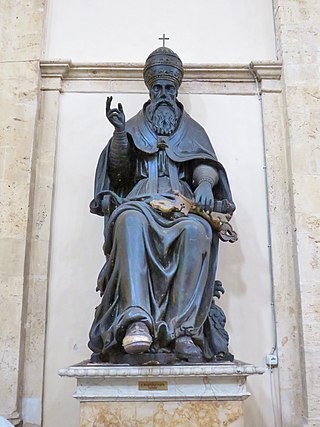
Pope Martin I, also known as Martin the Confessor, was the bishop of Rome from 21 July 649 to his death 16 September 655. He had served as Pope Theodore I's ambassador to Constantinople, and was elected to succeed him as pope. He was the only pope when Constantinople controlled the papacy whose election had not awaited imperial mandate. For his strong opposition to Monothelitism, Pope Martin I was arrested by Emperor Constans II, carried off to Constantinople, and ultimately banished to Cherson. He is considered a saint by both the Catholic Church and the Eastern Orthodox Church, as well as the last pope recognised as a martyr.
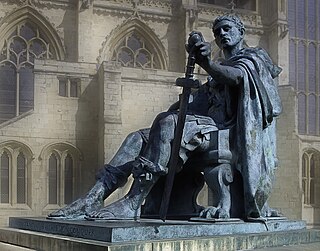
Year 306 (CCCVI) was a common year starting on Tuesday of the Julian calendar. At the time, it was known as the Year of the Consulship of Constantius and Valerius. The denomination 306 for this year has been used since the early medieval period, when the Anno Domini calendar era became the prevalent method in Europe for naming years.

A martyr is someone who suffers persecution and death for advocating, renouncing, or refusing to renounce or advocate, a religious belief or other cause as demanded by an external party. In colloquial usage, the term can also refer to any person who suffers a significant consequence in protest or support of a cause.
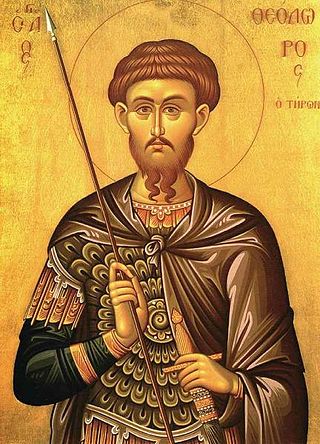
Saint Theodore, distinguished as Theodore of Amasea, Theodore the Recruit, and by other names, is a Christian saint and Great Martyr, particularly revered in the Eastern Orthodox Churches but also honored in Roman Catholicism and Oriental Orthodoxy. According to legend, he was a legionary in the Roman army who suffered martyrdom by immolation at Amasea in Galatian Pontus during the Great Persecution under Diocletian in the early 4th century. Venerated by the late 4th century, he became a prominent warrior saint during the Middle Ages, attracted a great deal of additional legends including accounts of battle against dragons, and was often confused with the similar Theodore Stratelates of Heraclea.

The Gnadenhutten massacre, also known as the Moravian massacre, was the killing of 96 pacifist Moravian Christian Indians by U.S. militiamen from Pennsylvania, under the command of David Williamson, on March 8, 1782, at the Moravian missionary village of Gnadenhutten, Ohio Country, during the American Revolutionary War.
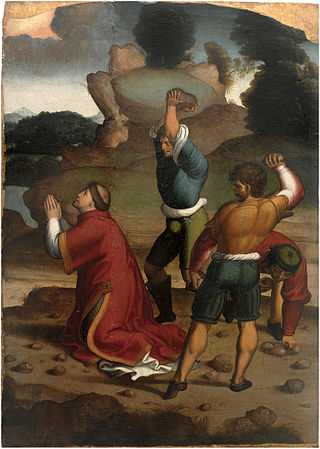
In Christianity, a martyr is a person who was killed for their testimony for Jesus or faith in Jesus. In the years of the early church, stories depict this often occurring through death by sawing, stoning, crucifixion, burning at the stake, or other forms of torture and capital punishment. The word martyr comes from the Koine word μάρτυς, mártys, which means "witness" or "testimony".
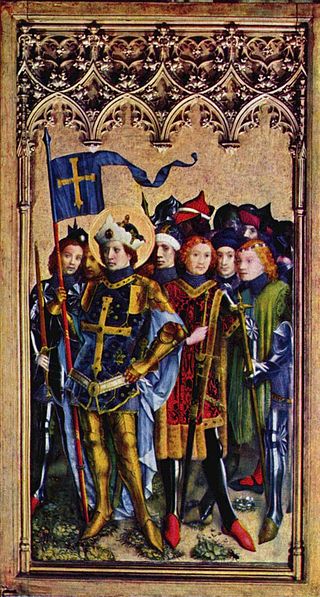
The Theban Legion figures in Christian hagiography as a Roman legion from Egypt —"six thousand six hundred and sixty-six men" — consisting of Christian soldiers who were martyred together in 286, according to the hagiographies of Maurice, the chief among the Legion's saints. Their feast day is held on September 22.
Saint Theodore may refer to:
Saints Theodora and Didymus are Christian saints whose legend is based on a 4th-century acta and the word of Saint Ambrose. The pair were martyred in the reigns of co-ruling Roman Emperors Diocletian and Maximianus. St. Theodora should not be confused with another St. Theodora of Alexandria commemorated on September 11.

The military saints, warrior saints and soldier saints are patron saints, martyrs and other saints associated with the military. They were originally composed of the early Christians who were soldiers in the Roman army during the persecution of Christians, especially the Diocletianic Persecution of AD 303–313.

Theodore Stratelates, also known as Theodore of Heraclea, was a martyr and warrior saint in the Eastern Orthodox, Catholic and Oriental Orthodox Churches.

Saint Diomedes of Tarsus (Diomede) is venerated as a Greek Christian saint and martyr, one of the Holy Unmercenaries.

Theodore George Romzha was a Ukrainian Catholic prelate who served as Bishop of the Greek Catholic Eparchy of Mukachevo from 1944 to 1947. Assassinated by the NKVD, he was beatified as a martyr by Pope John Paul II on 27 June 2001.
The title of New Martyr or Neomartyr is conferred in some denominations of Christianity to distinguish more recent martyrs and confessors from the old martyrs of the persecution in the Roman Empire. Originally and typically, it refers to victims of Islamic persecution.

Christians were persecuted throughout the Roman Empire, beginning in the 1st century AD and ending in the 4th century. Originally a polytheistic empire in the traditions of Roman paganism and the Hellenistic religion, as Christianity spread through the empire, it came into ideological conflict with the imperial cult of ancient Rome. Pagan practices such as making sacrifices to the deified emperors or other gods were abhorrent to Christians as their beliefs prohibited idolatry. The state and other members of civic society punished Christians for treason, various rumored crimes, illegal assembly, and for introducing an alien cult that led to Roman apostasy. The first, localized Neronian persecution occurred under Emperor Nero in Rome. A number of mostly localized persecutions occurred during the reign of Marcus Aurelius. After a lull, persecution resumed under Emperors Decius and Trebonianus Gallus. The Decian persecution was particularly extensive. The persecution of Emperor Valerian ceased with his notable capture by the Sasanian Empire's Shapur I at the Battle of Edessa during the Roman–Persian Wars. His successor, Gallienus, halted the persecutions.
Zanitas and Lazarus were martyrs of the Christian church in the Sasanid Empire.

Theodore is a masculine given name. It comes from the Ancient Greek name Θεόδωρος (Theódoros), meaning "gift of God(s)" (from the Ancient Greek words θεός, "God/Gods" and δῶρον "gift". The name was borne by several figures in ancient Greece, such as Theodorus of Samos and Theodorus of Byzantium, but gained popularity due to the rise of Christendom.
Confessor of the Faith is a title given by some Christian traditions. In Catholicism and Eastern Orthodoxy, Christians who professed their faith in times of Christian persecution and therefore had to suffer persecution, exile, torture, mutilation and/or imprisonment, but not directly undergo martyrdom, are called confessors. Later, popes, bishops, abbots, kings and hermits were also counted among the confessors.
Saint Theodora may refer to:

The Church Fathers, Early Church Fathers, Christian Fathers, or Fathers of the Church were ancient and influential Christian theologians and writers who established the intellectual and doctrinal foundations of Christianity. The historical period in which they worked became known as the Patristic Era and spans approximately from the late 1st to mid-8th centuries, flourishing in particular during the 4th and 5th centuries, when Christianity was in the process of establishing itself as the state church of the Roman Empire.